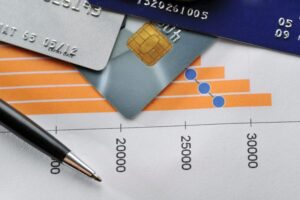As the world’s largest economy, the U.S. economy significantly influences global financial markets, trade, and investment strategies. Looking ahead to 2025, there are numerous factors at play that will shape the economic landscape, from technological innovation to inflation rates, policy decisions, and the ongoing recovery from the COVID-19 pandemic. This article explores key predictions and trends that are expected to impact the U.S. economy in 2025, providing valuable insights for investors, business owners, and consumers.
Economic Growth in 2025: Modest Recovery Amid Global Challenges
The U.S. economy in 2025 is likely to experience moderate growth. After navigating the economic upheaval caused by the COVID-19 pandemic, the U.S. has made significant strides in recovering from the recession. However, the growth rate is expected to be slower compared to the rapid recovery years immediately following the pandemic.
Experts predict a U.S. GDP growth rate of about 2-3% annually in 2025. While the economy is recovering, challenges such as rising labor costs, supply chain disruptions, and ongoing global uncertainties will continue to weigh on economic momentum. Moreover, the U.S. Federal Reserve’s actions, particularly in controlling inflation and managing interest rates, will play a crucial role in shaping overall economic performance.
Despite the potential for slower growth, certain sectors, particularly technology, healthcare, and clean energy, are expected to outperform the broader economy. These industries are positioned to lead the charge in contributing to economic growth, with demand for innovation and sustainability driving expansion.
Inflation and Interest Rates: The Fed’s Balancing Act
Inflation has been a critical issue for the U.S. economy in recent years, driven by pandemic-related disruptions, fiscal stimulus, and supply chain imbalances. As of 2025, inflation is expected to moderate, but it will still remain a concern, particularly in sectors like housing, healthcare, and energy.
The U.S. Federal Reserve is likely to continue its efforts to control inflation through monetary policy, including adjusting interest rates. By 2025, interest rates may remain relatively higher than the ultra-low rates seen during the pandemic era. The Fed’s decision on interest rates will be influenced by inflationary pressures and the need to strike a balance between encouraging investment and curbing inflation.
While inflation is expected to moderate, rising wages and higher production costs will likely continue to drive prices up in certain sectors. For example, the housing market may face persistent affordability issues due to higher material and labor costs. Similarly, energy prices may fluctuate depending on global supply and demand.
Labor Market in 2025: The Rise of Remote Work and Automation
The U.S. labor market has undergone significant changes in recent years, largely driven by the pandemic. Remote work became the norm for many industries, and flexible work arrangements are now expected to remain a fixture in the workplace of 2025. Technology will play a pivotal role in shaping the workforce, and the trend toward automation and artificial intelligence (AI) is expected to accelerate.
In 2025, the labor market is expected to experience lower unemployment rates, but the job market will be highly competitive. While some industries, such as healthcare, technology, and green energy, will see growth and an increased demand for skilled workers, other sectors may struggle due to automation and outsourcing.
For example, roles in traditional manufacturing or customer service may be at risk of automation, while tech-driven sectors like software development, cybersecurity, and data analysis will continue to grow. The rise of AI and machine learning will also reshape how businesses approach problem-solving and operations, pushing demand for workers with technical expertise.
Technological Innovation: The Next Wave of Disruption
Technology has been the driving force behind U.S. economic growth for decades, and by 2025, it is expected to continue its dominance in shaping the economy. The adoption of 5G technology, artificial intelligence, robotics, and blockchain are just a few examples of innovations that will transform industries across the board.
The technology sector will remain a key player in driving growth, with advancements in fields like renewable energy, electric vehicles (EVs), and healthcare technology spurring new investment opportunities. The U.S. is expected to lead the world in EV production and adoption by 2025, with automakers shifting toward fully electric or hybrid models. Additionally, the growing demand for clean energy sources will create new job opportunities and stimulate economic activity in renewable energy sectors such as solar and wind power.
In the financial sector, blockchain technology and decentralized finance (DeFi) are poised to continue disrupting traditional banking and financial systems. These innovations offer faster, more secure ways of transacting business, and the U.S. will likely continue its role as a global leader in fintech development and adoption.
The Green Economy: Clean Energy and Sustainability
Environmental sustainability will be a central theme of the U.S. economy by 2025, with growing concerns over climate change driving policy changes and industry shifts. The Biden administration has already set ambitious goals to address climate change, such as achieving net-zero carbon emissions by 2050. As a result, the green economy—comprising renewable energy, clean technology, and sustainable practices—is expected to expand rapidly in the next few years.
By 2025, the clean energy sector is expected to see continued growth, with increasing investments in wind, solar, and other renewable energy sources. Furthermore, electric vehicles (EVs) will become a significant part of the automotive landscape, with both established automakers and new companies pushing the transition toward electric fleets. This will have a ripple effect on industries related to battery production, energy storage, and infrastructure development.
Investors are also increasingly turning to sustainable investing, prioritizing companies that have strong environmental, social, and governance (ESG) practices. The U.S. is expected to see continued growth in ESG-driven investments, with institutional investors and individual shareholders increasingly seeking out businesses that are committed to sustainability and climate action.
Global Trade and Geopolitical Risks
Global trade and geopolitical risks will continue to shape the U.S. economy in 2025. Trade relations with China, Europe, and other global partners will remain a focal point, with ongoing negotiations and tariffs potentially impacting the flow of goods and services.
The ongoing trade war with China is expected to have lasting implications for the U.S. economy, particularly in sectors like technology and manufacturing. On the other hand, the Biden administration’s push for more multilateral trade agreements and alliances may help to ease some of the tensions and provide more stable trading conditions.
Geopolitical risks such as tensions in Eastern Europe, cyber threats, and climate-related disasters could also impact global supply chains, driving up costs and affecting U.S. exports and imports. The U.S. will need to balance its domestic economic priorities with its role in global trade, requiring careful navigation of international relations.
Conclusion
The U.S. economy in 2025 is expected to be characterized by steady but moderate growth, with innovation in technology, sustainability, and labor markets driving new opportunities. While inflation and interest rates will likely remain key concerns, the U.S. is well-positioned to take advantage of its leadership in areas like technology, clean energy, and fintech.
For investors, understanding these economic trends and positioning portfolios for the future will be essential. The economic landscape will evolve, but with careful planning and an eye on emerging opportunities, both businesses and individuals can navigate the challenges and capitalize on the growth areas of 2025.
FAQ
1. What is the U.S. GDP growth rate expected to be in 2025?
Experts predict the U.S. GDP growth rate in 2025 will be around 2-3%, reflecting a moderate recovery after the pandemic with some challenges in global trade and inflation.
2. How will technology impact the U.S. economy by 2025?
Technology, particularly in areas like AI, 5G, blockchain, and clean energy, will drive significant growth in the U.S. economy. Innovation in these sectors will create new jobs, boost productivity, and contribute to overall economic expansion.
3. Will the U.S. labor market improve in 2025?
The U.S. labor market is expected to experience lower unemployment rates in 2025, but the demand for workers will be highly competitive. Technological advancements, particularly automation, will reshape industries, with a stronger focus on skilled labor in tech-driven sectors.
In conclusion, the U.S. economy in 2025 is expected to see a period of recovery and growth, but challenges like inflation, geopolitical risks, and labor market shifts will persist. The country’s continued leadership in technology, clean energy, and fintech will likely define the future of its economy. By staying informed about these emerging trends, individuals and businesses can position themselves to thrive in the evolving economic landscape.







